Abstract
OBJECTIVE--To determine the effectiveness of an existing screening programme based in the community for ocular and vision defects in infants considered at increased risk of such defects. DESIGN--Children with ocular or vision defect by the age of 2 were ascertained by searching records. Those from populations at high risk were matched with their results from screening tests. The characteristics of the cases among this population were compared with those of the cases in the remainder of the population. Patterns of referral and age at referral were studied in both groups. SETTING--The study was conducted within Oxfordshire Health District. SUBJECTS--433 Children at high risk born in 1984 to mothers living in the health district at delivery and who either weighed less than 2000 g or weighed 2000 g and over and required admission to a special care nursery for longer than 24 hours. The low risk population (6254) were infants without these characteristics who were resident in the health district at the time of referral. INTERVENTIONS--Screening tests for vision or ocular defects already routinely used were applied by health visitors at 8 and 18 months to the children at high risk. MAIN OUTCOME MEASURE--Comparison of results of screening tests with vision and ocular defects detected by the age of 2. RESULTS--Screening tests in current use for vision loss and squint in this age group were insensitive and had a low positive predictive value when applied to a high risk population. Defects that were not apparent on direct inspection were unlikely to be detected by these tests. In the high risk group the relative risk of having a defect was 2.8 (95% confidence interval 1.8 to 4.5) but 85% of all cases detected by the age of 2 were in children at low risk. Referral patterns and age of referral differed in the two groups. CONCLUSIONS--Screening by health visitors of high risk populations contributes little to the detection of vision and ocular defects. This type of evaluation needs to be applied also to low risk populations, who have different referral patterns and contribute most of the cases.
Full text
PDF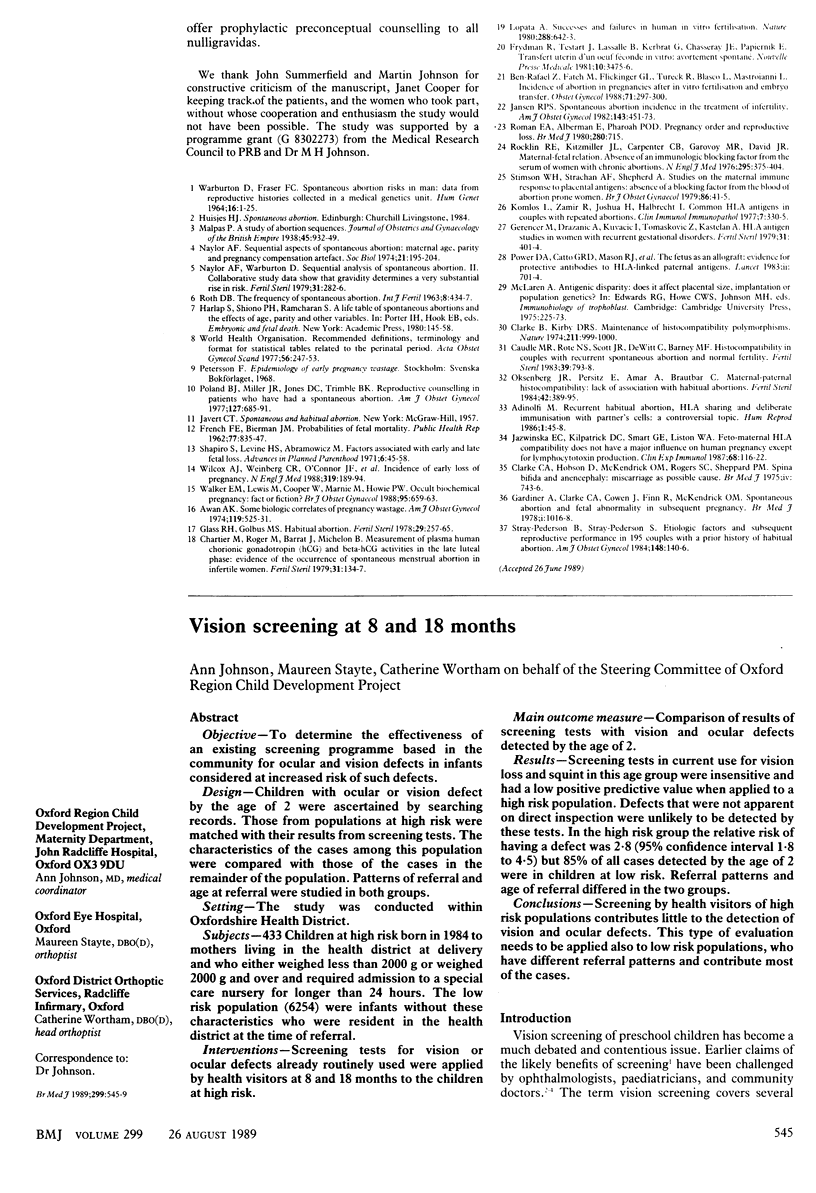
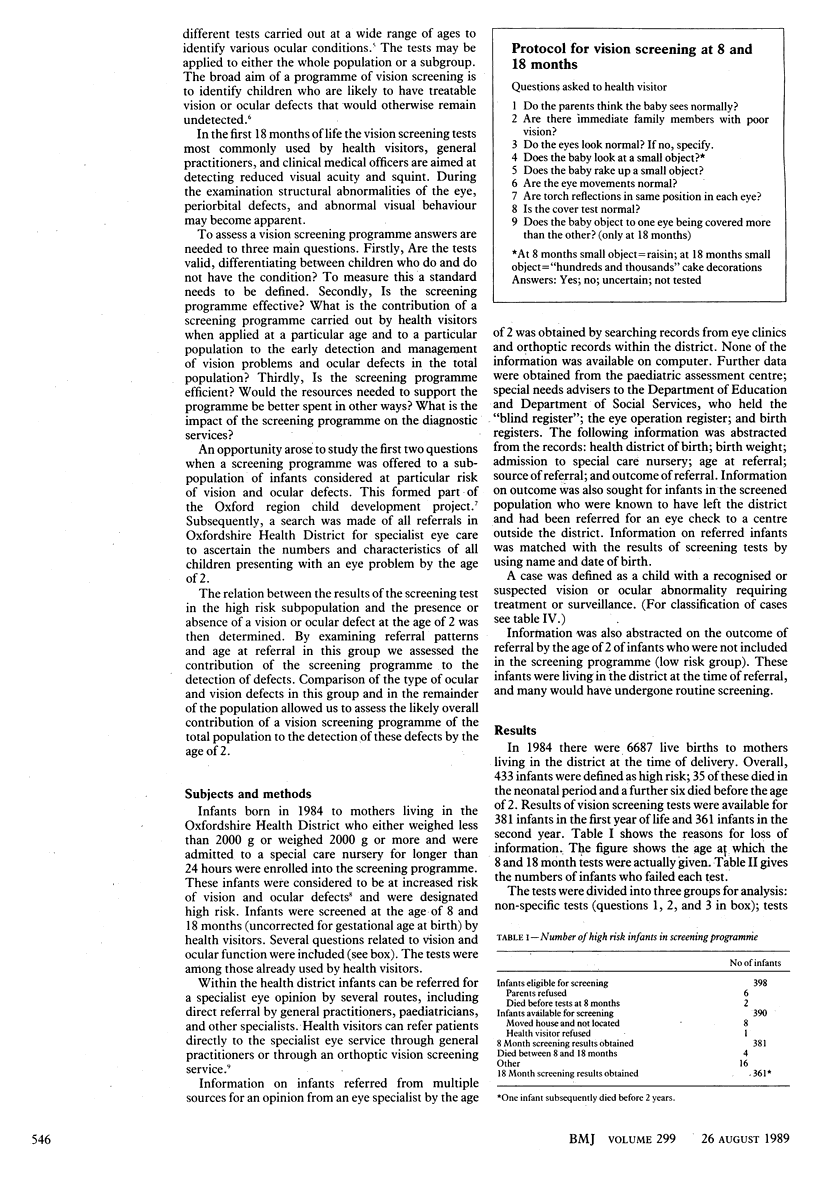
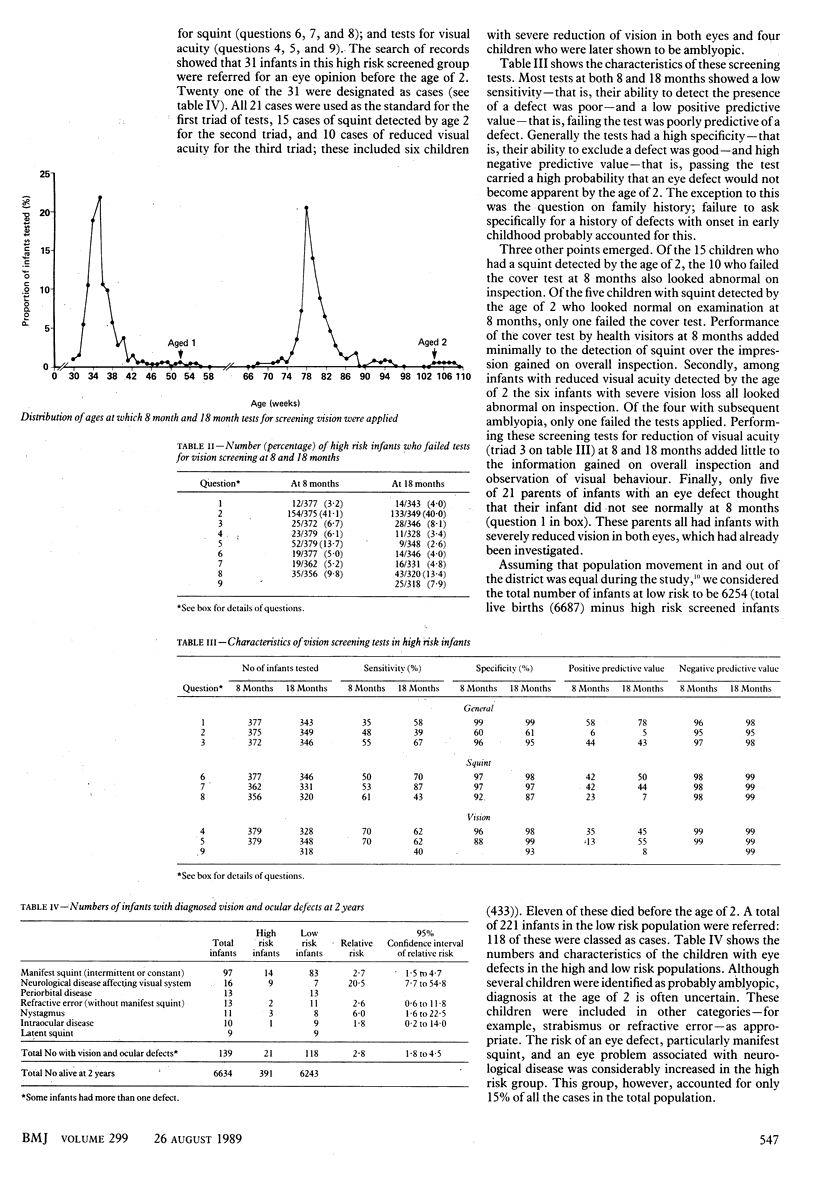
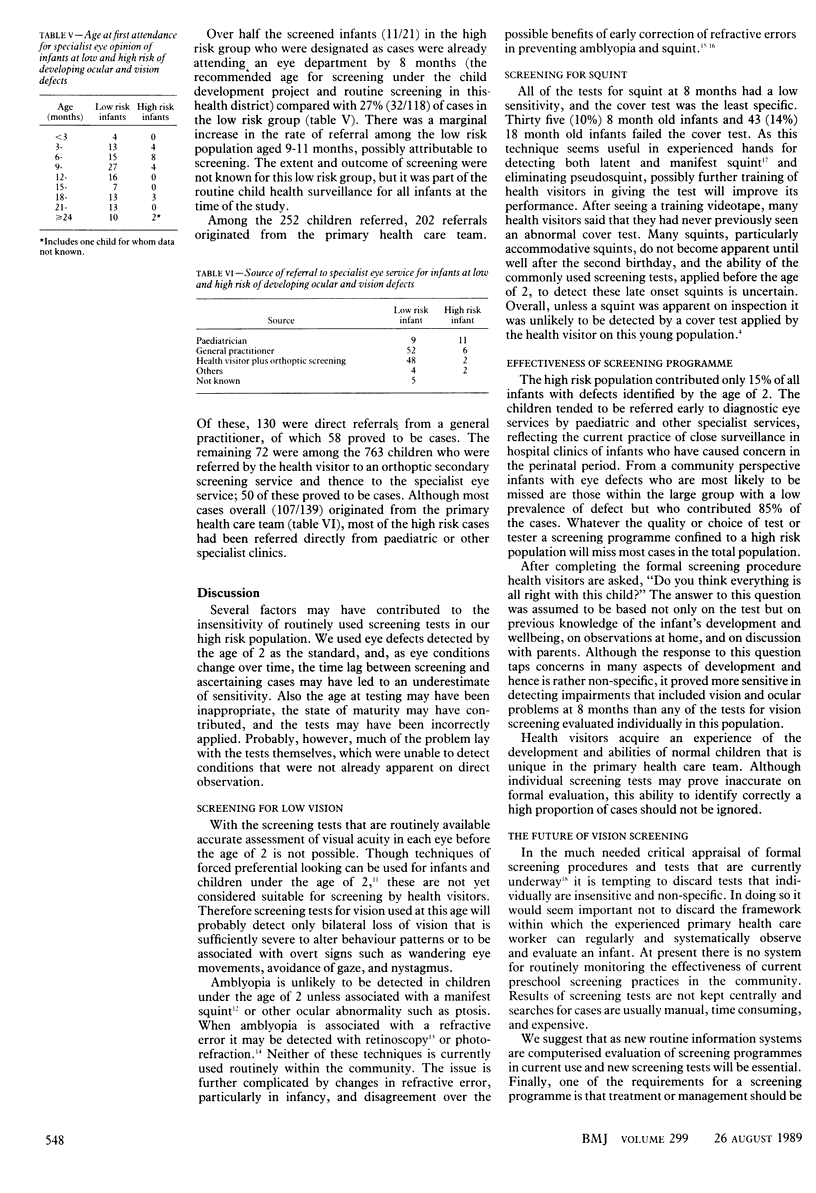
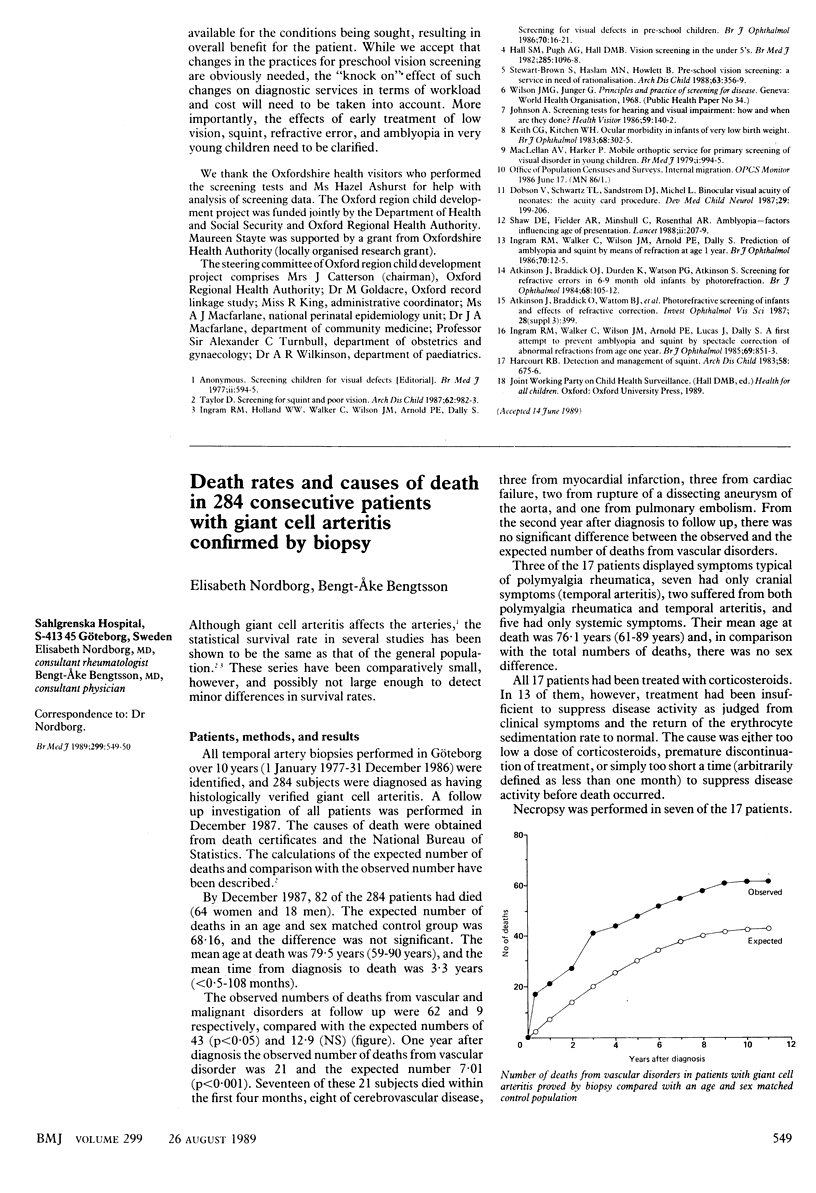
Selected References
These references are in PubMed. This may not be the complete list of references from this article.
- Atkinson J., Braddick O. J., Durden K., Watson P. G., Atkinson S. Screening for refractive errors in 6-9 month old infants by photorefraction. Br J Ophthalmol. 1984 Feb;68(2):105–112. doi: 10.1136/bjo.68.2.105. [DOI] [PMC free article] [PubMed] [Google Scholar]
- Dobson V., Schwartz T. L., Sandstrom D. J., Michel L. Binocular visual acuity of neonates: the acuity card procedure. Dev Med Child Neurol. 1987 Apr;29(2):199–206. doi: 10.1111/j.1469-8749.1987.tb02136.x. [DOI] [PubMed] [Google Scholar]
- Hall S. M., Pugh A. G., Hall D. M. Vision screening in the under-5s. Br Med J (Clin Res Ed) 1982 Oct 16;285(6348):1096–1098. doi: 10.1136/bmj.285.6348.1096. [DOI] [PMC free article] [PubMed] [Google Scholar]
- Harcourt R. B. Detection and management of squint. Arch Dis Child. 1983 Sep;58(9):675–676. doi: 10.1136/adc.58.9.675. [DOI] [PMC free article] [PubMed] [Google Scholar]
- Ingram R. M., Holland W. W., Walker C., Wilson J. M., Arnold P. E., Dally S. Screening for visual defects in preschoolchildren. Br J Ophthalmol. 1986 Jan;70(1):16–21. doi: 10.1136/bjo.70.1.16. [DOI] [PMC free article] [PubMed] [Google Scholar]
- Ingram R. M., Walker C., Wilson J. M., Arnold P. E., Dally S. Prediction of amblyopia and squint by means of refraction at age 1 year. Br J Ophthalmol. 1986 Jan;70(1):12–15. doi: 10.1136/bjo.70.1.12. [DOI] [PMC free article] [PubMed] [Google Scholar]
- Ingram R. M., Walker C., Wilson J. M., Arnold P. E., Lucas J., Dally S. A first attempt to prevent amblyopia and squint by spectacle correction of abnormal refractions from age 1 year. Br J Ophthalmol. 1985 Nov;69(11):851–853. doi: 10.1136/bjo.69.11.851. [DOI] [PMC free article] [PubMed] [Google Scholar]
- Keith C. G., Kitchen W. H. Ocular morbidity in infants of very low birth weight. Br J Ophthalmol. 1983 May;67(5):302–305. doi: 10.1136/bjo.67.5.302. [DOI] [PMC free article] [PubMed] [Google Scholar]
- MacLellan A. V., Harker P. Mobile orthoptic service for primary screening of visual disorder in young children. Br Med J. 1979 Apr 14;1(6169):994–995. doi: 10.1136/bmj.1.6169.994. [DOI] [PMC free article] [PubMed] [Google Scholar]
- Screening children for visual defects. Br Med J. 1977 Sep 3;2(6087):594–595. [PMC free article] [PubMed] [Google Scholar]
- Shaw D. E., Fielder A. R., Minshull C., Rosenthal A. R. Amblyopia--factors influencing age of presentation. Lancet. 1988 Jul 23;2(8604):207–209. doi: 10.1016/s0140-6736(88)92301-x. [DOI] [PubMed] [Google Scholar]
- Stewart-Brown S. L., Haslum M. N., Howlett B. Preschool vision screening: a service in need of rationalisation. Arch Dis Child. 1988 Apr;63(4):356–359. doi: 10.1136/adc.63.4.356. [DOI] [PMC free article] [PubMed] [Google Scholar]
- Taylor D. Screening for squint and poor vision. Arch Dis Child. 1987 Oct;62(10):982–983. doi: 10.1136/adc.62.10.982. [DOI] [PMC free article] [PubMed] [Google Scholar]


